| enter keyword to search: |
|
Images db
|
|
|
Articles db
|
|
|
|
|
| Orissan Temple Architecture |
|
|
|
Orissa has a rich heritage of temple architecture full of excellent sculptural works culminating in the temples of the well known golden triangle of Bhubaneswar-Puri-Konark. Regarded as part of the northern Nagara style, the Orissan regional style os also called Kalinga style. Inspired by the patronage of rajas and by the Hindu hegemony, without any Islamic or Persian influence, this Orissan sub-regional style continued with unbroken continuity for nearly one thousand years, from the vi - vii century to the xv - xvi century AD, reaching the climax during the Ganga period. Unlike other temples in the north, Orissan temples have largely survived.
Orissan Temple Architecture |
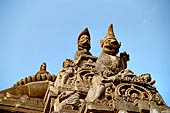
|
Temple description
The two main elements of the temple in Orissa are called Deul, corresponding to the sikhara, and Jagamohan, the assembly hall. The curvilinear superstructure of the deul is of rekha order, while the jagamohan is characterised by a pyramidal corbelled roof (pitha deul) whose shape recalls the thatched hut of villages. A unicum in the Orissan style is Vaital deul at Bhubaneswar, characterised by a tower topped with a semi-cylindrical vault, called khakhara, in all similarity to the southern Dravidian Gopura. In later times two other structures are added to the temple, the bhogamandapa (offering hall) and the natamandapa (dancing hall). The lion-gate at the entrance (simhadwara) is a distinctive feature of Orissan temples, with lions that are not naturalistically sculpted, with funny big noses and thick moustaches.
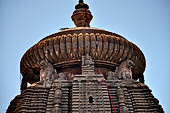
|
Orissan Temple Architecture
|
Temples are built of huge blocks of sandstone, without mortar, around an inner core of laterite. The temple walls are broken into sections by vertical projections, staggered in various combinations, rising from the base to the top in a buttress arrangement. The central and the most pronounced of these projections of the deul is called Raha paga, and the aedicule niche in it usually enshrines the image of the divinity to whom the temple is dedicated.
Characteristic feature of Orissan temples is the mastaka, the 'head' of the temple, with its amalaka, the ribbed circular stone supported by seated divinities and surmounted by a vase finial with at the very top the 'divine weapon' of the resident deity: the Shivaite trident or the Vaishnavite chakra.
Orissan Temple Architecture |
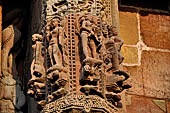
|
The entire wall surfaces are covered by innumerable sculptures: gods and goddesses, matrikas, the eight or nine planets (astagraha , navagrahas) panel on the entrance lintel, dikpalas the 'maintainer of direction' in their specified corner, panel with guru instructing his disciples (sikshadana), beautiful female figures (nayika) adorned with all ornaments and in various graceful postures, the auspicious motif called alasa kanya (indolent maiden), semi-divine beings as 'nagas' and 'naganaginis', gajasimha the lion rearing over or a kneeling elephant, jodisingha the jointed lion placed at the corners, virala (vyala) the dragon-serpent in various forms: nara-virala (half lion-half human), simha-virala (with a lion's head), gaja-virala (with an elephant head), (Konarak Surya temple), virala ridden by a yogi (Rajarani Bhubaneswar) representing the wise who tames the natural world, chaitya medallions with face images in the centre, pattern of the so called gavakshas the horseshoe arch motif, the bho motif composed by an ornate chaitya medallion flanked by attendants, the kirtimukha (head of glory) the mythical lion head without the lower jaw regurgitating garlands.
It is also noticeable that the interiors of the temples are almost invariably plain and austere in comparison with their highly ornamented exteriors.
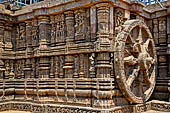
|
Orissan Temple Architecture
|
A feature which attracts frequent notice is the presence of erotic figures of loving couples maithunas (Sun temple at Konark). Far from being an anomaly in Hindu culture, the erotic sculptures are in harmony with the religious environment and the courtly life of the time. These erotic images have been also interpreted as secret language and symbolic representation of medieval Tantric philosophy which grew in Orissa from vii c A.D. and that contributed to the worship of mother-goddess as the source of power (shakti).
Orissan Temple Architecture |
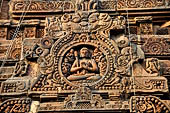
|
Temples timeline
Parsurameswar temple in Bhubaneswar (vii c. AD) is the best preserved temple of the formative phase with moderate height and sculptures in low relief.
Vaital, Sisireswar and Mukteswar in Bhubaneswar (ix c - xi c AD) belongs to the transitional phase with the appearance of erotic sculptures due to the influence of Vajrayana philosophy.
With Rajarani, Brahmeswar and Lingaraj, (xi c - xiii c) the Orissan style reaches its peack.
This tradition was continued by the Gangas with the construction of the great Jagannath temple at Puri and reaching the climax with the magnificent Sun Temple of Konark. After Konark the decline of royal patronage and Hindu power leads the halt of the great period of Orissan temple architecture.
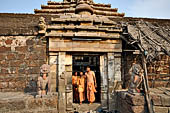
|
Orissan Temple Architecture
|
|
Related Pages
-
-
-
-
-
-
|
|
|
 |
|
|



